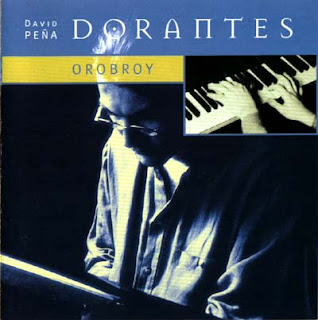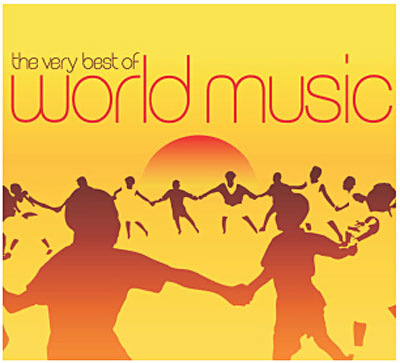-
Par DJDemonAngel le 16 Janvier 2010 à 19:00

http://www.dorantes.es/
The first work by this genius of the piano who comes from one of the great flamenco families, the same one as El Lebrijano. The record is a daring challenge in which an innovative, evolving kind of flamenco is throbbing, and Dorantes´ piano combines with the viola, violin and percussion, but without a guitar.
permalink
Note :



Tracklist
1. Semblanzas de un río
2. Abuela perrata
3. Orobroy
4. Ventanales
5. Gallardó
6. Silencio de patriarca
7. Gañanía
8. Nana de los luceros
9. Oleaítas, mare

 votre commentaire
votre commentaire
-
Par DJDemonAngel le 8 Janvier 2010 à 17:00


http://www.myspace.com/tagaq
C’est quoi?
C’est Auk/blood, le troisième album de Tagaq. Originaire du Nunavut, elle pratique et actualise le chant de gorge traditionnel et a collaboré, en 2004, à l’album Medúlla, de Bjork, qui a qualifié Tagaq d’« Édith Piaf ou quelque chose de totalement… émotionnel ».
Actualiser le chant de gorge, ça se peut?
Traditionnellement un jeu, le chant de gorge oppose deux femmes qui se font face et chantent dans le but de faire rire leur adversaire. Tagaq réussit à elle seule (à l’aide d’échantillonneurs) à reproduire l’ensemble du spectre vocal et à l’accoupler à des sonorités qui ne sont pas sans rappeler l’esthétisme folktronica.
Ça doit devenir redondant?
Presque, mais comme Tagaq semble consciente des limites esthétiques inhérentes au genre, elle s’entoure de collaborateurs qui l’aident à repenser constamment son projet musical. Et si Mike Patton (ancien Faith No More et Mr. Bungle) collabore à une pièce, c’est Buck 65 qui offre les contributions les plus intéressantes. Par contre, une réalisation très (trop) propre enlève un peu de vérité au côté plus organique de la chose. Mais c’est, dans l’ensemble, le seul bémol à émettre au sujet de ce disque fort intéressant.Une écoute gutturale de François Lemay
Tanya Tagaq @ YBCA
Note :


Tracklist:
1. Fox - Tiriganiak
2. Fire - Ikuma
3. Growth
4. Gentle
5. Tategak
6. Force
7. Growl
8. Want
9. Hunger
10. Burst
11. Auk - Blood
12. Construction
13. Sinialuk

 votre commentaire
votre commentaire
-
Par DJDemonAngel le 7 Janvier 2010 à 11:00


http://www.alexkajumulo.com/
http://www.myspace.com/alexkajumulo
I was born and raised in the bush of Tanzania, Africa. He moved to the city, Dar es Salaam, when he was 13 and started playing professional soccer at 15. I played Soccer all over the world: Tanzania, Djibouti, Yemen, Saudi Arabia, France, Holland, Japan, and the United States. After retiring from playing soccer, I ended up in Seattle, Washington. Here I coach a Youth Select Soccer Team and design, manufacture, and sell soccer uniforms and gear to teams and individuals around the world.
I have always played music since I was a kid, because when you are a bush man, you have to sing and play beats to yourself to keep entertained. In the bush when I was a kid I had no radio or TV. All my life I have been making music in my head.
In 1999, I had the chance to produce an album for "Cool James" Dandu. Also known as Mtoto wa Dandu. The Album was called "CJ Massive: African Most Wanted" and was a big hit in East Africa and in African communities around the world. Sadly, Cool James was killed in a car crash in Dar es Salaam, Tanzania. Myself and all Tanzanians miss his musical talent. But he inspired me to continue to create music.
This year I have begun putting together my own album. I am going to call this album "Never Before" because it’s a new style of music never heard before.
permalink
Note :



Tracklist :
01 One Love is the Law 04:34
02 Maza Africa 05:15
03 Whos the Real Cowboy 04:48
04 Like Me 04:31
05 Never Before 04:46
06 Its Me Again Jah 04:18
07 Malaika 04:19
08 Zuwena 04:57
09 Love is the Only Thing I Got 05:02
10 Nairobi 03:28
11 Be My Wifey Wifey 04:24
12 Babu Kaju 04:46

 votre commentaire
votre commentaire
-
Par DJDemonAngel le 22 Décembre 2009 à 18:57

DJ DemonAngel present 50 World Music (2009)
PLAYLIST :
01 - Umalali - anaha ya (here i am)
02 - Mercan Dede - Napas
03 - Quantic and His Combo Barbaro - Un canto a ma tierra
04 - Toma Bebic - tu-tu auto, vrag ti piz odnija
05 - Bzunesh Bekele - Atrakegn
06 - Gilberto Gil - Kaya N'gan Daya (Kaya)
07 - Felipecha - Juanitita
08 - Gal Costa - Tuang
09 - Kocani Orkestar - Papigo
10 - La Chicana - Sutil alarido
11 - LaXula - Soberbía
12 - Gift of Gab - Lateef - Mixmaster Mike - Kalakuta show
13 - Groupe Oyiwane - Tagot
14 - The Klezmatics & Chava Alberstein - Ovnt lid
15 - African All Stars - Les champions
16 - EsperanSaharaui - La Kinky Beat + Bad Sound System + Sorkun
17 - Auk & Tagaq - Fire - Ikuma
18 - Moussu T e Lei Jovents - Ma rue n'est pas longue
19 - La Rue Ketanou - Ton cabaret
20 - Lura - Mascadjon
21 - Mukta - Fraction
22 - Nour - Une Petite Dose
23 - Rodrigo y Gabriela - Savitri
24 - Chang Loo - All the stars in the sky
25 - Shinichi Kinoshita with Roby Lakatos - So gu
26 - Tarika - Avelo (Ghost)
27 - Susheela Rama - Yoo do right
28 - The Pearl Sisters - A cup of coffee
29 - Zaka Percussion - Sahel
30 - Fanga - Natural Juice (Ashanti Mix)
31 - Varttina - Akkaralaisen turistin maahanpanopolkka
32 - Mari Boine - Skealbma (the Mischievous)
33 - Ninji-Ninji - Walkabout
34 - Kongar-ol Ondar And Paul Eart - Kargyraa moan
35 - Suda Chuenbarn - Funky Broadway
36 - Geraldo Pino & the Heartbeats - Right in the centre
37 - Dikanda - Kaman song
38 - Champloose & Shoukichi Kinathe - bancho guwa
39 - Joe Cuba - Quinto
40 - Ferro Caita - Ferro gaita
41 - Seu Jorge - Eterna busca
42 - Mamani Keita & Marc Minelli - N'Ka Willy
43 - Arthur H - Mon nom est kevin b
44 - Ilya - River Of Light
45 - Abjeez - Immigrant
46 - Dub Colossus - Shem city steppers
47 - Leroy Sibbles - Blook in the street
48 - Goran Bregovic - Soferska
49 - Ikue Asazaki - obokuri-eeumi
50 - Oki - Utari

 votre commentaire
votre commentaire
-
Par DJDemonAngel le 10 Décembre 2009 à 17:00


And this is how it all began... Around the 9th Century, for reasons unknown, thousands of inhabitants of the northwestern part of India began to emigrate west. They set out from the territories now known as the Punjab and Pakistan. In Persia they split, and some travelled via Palestine, Egypt and Morocco and through the Strait of Gibraltar, finally arriving, known already as Gypsies, in the south of Moorish Spain. In this region, previously known as Al-Andalus, various cultures co-existed for hundreds of years. That was perhaps the only place where Gypsies, Jews, Christians and Muslims lived peacefully together for a many years. Each group had its own customs, music's and instruments. After many years, in the beginning of the 19th Century, due to mutual influences and the mingling of their musical expressions, a mysterious and expressive type of music emerged. Today, it is know as Flamenco. The Middle East, specifically India, was a cradle of the culture and language of most of Europe. Inhabitants of its northern regions together with Egypt, Mesopotamia, and China constituted the oldest civilizations in the world. It was there, in the Indus river valley, where the first religions, first laws and first instruments and musical notations appeared. The oldest record, written in India around 2000 BC, sets out mantras chanted to honour their gods. Based upon one, two or three notes, these chants were over time transformed into a heptatonic scale. The seven-note scale, already popular in 350 BC, was written as Sa, Re, Ga, Ma, Pa, Dha, Ni, and remains in this form today. Somewhere between the Second and Fifth Centuries the first book devoted to the art was written. It was called Bharata Natya Shastra. It contained a detailed description of vocal, dance and instrumental music. According to this book, Indian music is based on raga, that is a sequence of at least five notes of one scale. A melody governed by raga is performed according to specific principles and with a certain mood. In the Sixth Century canons for music and art were established. This gave rise to the development of classical Indian music, which was based upon the system of ragas and rhythms accompanying them. To this day, they remain unchanged. This musical culture also influenced other countries. Indian Brahmins introduced it to Persia and Arabia, and from there it was disseminated through the West. Simultaneously, Arab music entered Andalusia, than ruled by the Moors. The first monarch of Al-Andalus, Abd ar-Rahman I, invited to his court Arab musicians, who brought poetry, songs, musicians and musical instruments. In 822 a poet and singer came from Baghdad to Cordoba. His name was Abu al-Hasan Alî ibn Nafi and he was known as Zyryab (black bird). This extremely talented man played a key role in the musical education of the whole of Al-Andalus establishing an academy in which numerous musicians were trained. He introduced an Arab-Persian system of musical notation and improved the Arabian oud, which became a prototype of the contemporary guitar. Many years later musical development in India reached its peak. The great poet, musician and expert in Indian, Persian and Arab music, Amir Khushro (1254 - 1324) became a minister of a Mughal sultan. What he did for Indian music was unequalled by anything done before or after his time. He introduced many ragas and rhythms and, above all, he created two new instruments, which today is the basis of Indian music: the sitar and tabla. Banished from their native country these Indians wandered slowly further west, absorbing facets of the cultures of the countries through which they passed. When they reached Spain they were no longer the same people. Although they looked similar, in terms of culture, language, customs as well as music they had considerably changed. Unfortunately, they did not record their music; we do not know how it sounded, or how much of it has survived. And do not know what mark it has left, if any, on the flamenco and which of its elements are rooted in India and which in Andalusia. But even if both these fascinating genres cannot be proved to be closely related, listening their emotionality, expression, rhythm, depth and sensitivity must convince the listener that related they must be. Text by Miguel Czachowski
permalink
 2 commentaires
2 commentaires Suivre le flux RSS des articles de cette rubrique
Suivre le flux RSS des articles de cette rubrique Suivre le flux RSS des commentaires de cette rubrique
Suivre le flux RSS des commentaires de cette rubrique





